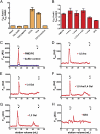Metabolic click-labeling with a fucose analog reveals pectin delivery, architecture, and dynamics in Arabidopsis cell walls
- PMID: 22232683
- PMCID: PMC3268317
- DOI: 10.1073/pnas.1120429109
Metabolic click-labeling with a fucose analog reveals pectin delivery, architecture, and dynamics in Arabidopsis cell walls
Abstract
Polysaccharide-rich cell walls are a defining feature of plants that influence cell division and growth, but many details of cell-wall organization and dynamics are unknown because of a lack of suitable chemical probes. Metabolic labeling using sugar analogs compatible with click chemistry has the potential to provide new insights into cell-wall structure and dynamics. Using this approach, we found that an alkynylated fucose analog (FucAl) is metabolically incorporated into the cell walls of Arabidopsis thaliana roots and that a significant fraction of the incorporated FucAl is present in pectic rhamnogalacturonan-I (RG-I). Time-course experiments revealed that FucAl-containing RG-I first localizes in cell walls as uniformly distributed punctae that likely mark the sites of vesicle-mediated delivery of new polysaccharides to growing cell walls. In addition, we found that the pattern of incorporated FucAl differs markedly along the developmental gradient of the root. Using pulse-chase experiments, we also discovered that the pectin network is reoriented in elongating root epidermal cells. These results reveal previously undescribed details of polysaccharide delivery, organization, and dynamics in cell walls.
Conflict of interest statement
The authors declare no conflict of interest.
Figures





References
-
- Somerville C, et al. Toward a systems approach to understanding plant cell walls. Science. 2004;306:2206–2211. - PubMed
-
- Cosgrove DJ. Growth of the plant cell wall. Nat Rev Mol Cell Biol. 2005;6:850–861. - PubMed
-
- Somerville C. Cellulose synthesis in higher plants. Annu Rev Cell Dev Biol. 2006;22:53–78. - PubMed
-
- Reiter WD, Chapple C, Somerville CR. Mutants of Arabidopsis thaliana with altered cell wall polysaccharide composition. Plant J. 1997;12:335–345. - PubMed
-
- Brown DM, et al. Comparison of five xylan synthesis mutants reveals new insight into the mechanisms of xylan synthesis. Plant J. 2007;52:1154–1168. - PubMed
Publication types
MeSH terms
Substances
LinkOut - more resources
Full Text Sources
Other Literature Sources

